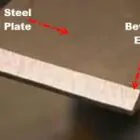Arc welding is a type of welding that uses an electric arc to melt and join metals by creating heat. With either direct (DC) or alternating (AC) currents, a power supply makes an electric arc between a consumable or non-consumable electrode and the base material.
How is Arc Welding done?
This form of welding is a method of fusing metals together. An electric arc from an AC or DC power source makes a lot of heat, about 6500°F, which melts the metal where two pieces of work come together.
You can move the Arc by hand or by machine, and the electrode can either carry the current or melt into the weld pool to add filler metal.
Because oxygen and nitrogen react chemically with metals when its hot by an arc, a shielding gas or slag keeps molten metal from coming in touch with air. When the molten metals cool, they solidify into a metallurgical bond.
How many different kinds of arc welding are there?
This process can be put into two groups: those that use consumable electrodes and those that don’t.
Consumable Electrode Methods.
Gas Metal Arc Welding (GMAW), also called Metal Inert Gas Welding (MIG) and Metal Active Gas Welding (MAG), uses a shielding gas to keep the base metals from getting contaminated.
Welding with a shielded metal arc (SMAW).
Flux shielded arc welding, also called “stick welding” is a process in which an arc is struck between a flux-coated metal rod and the work piece. Both the rod and the work piece surface melt, making a “weld pool.” When the flux coating on the rod melts at the same time, gas and slag are made, which protect the weld pool from the air. This process can be used to join both ferrous and non-ferrous materials of different thicknesses and in any position.
Welding with a flux-cored arc (FCAW).
FCAW is an alternative to SMAW. It uses a flux-cored consumable electrode and a constant voltage power supply to keep the length of the arc constant. This process can protect against contamination by using a shielding gas or just the gas made by the flux.
Welding with a submerged arc (SAW).
A technique that uses a constantly-fed electrode and a blanket of fusible flux that melts and forms a route between the part and the electrode. The flux also keeps splashes and sparks from happening and cuts down on fumes and UV radiation.
Welding with electro-slag (ESW).
A vertical process used to join plates that are thicker than 25 mm in a single pass. ESW starts with an electric arc that’s extinguished with flux. As the wire is fed into the molten pool, the flux melts, which makes a molten slag on top of the pool. The resistance of the molten slag to the flow of the electric current makes heat that melts the wire and plate edges. Two water-cooled copper shoes follow the process and prevents molten slag from escaping.
Arc Stud Welding (SW).
SW is like flash welding in that it joins a nut or fastener to another metal piece. The nut or fastener usually has a flange with nubs that melt to make the join.
Electrode Methods That Don’t Use Anything.
Tungsten Inert Gas Welding (TIG).
Gas Tungsten Arc Welding, or GTAW, uses a non-consumable tungsten electrode to make the arc and an inert shielding gas to keep the atmosphere from contaminating the weld and molten pool.
Welding with Plasma Arc (PAW).
PAW uses an electric arc between a non-consumable electrode and an internal anode. The electric arc ionize the gas in the torch and make it plasma. The plasma then goes to the base plate through a small hole in the anode. In this way, the plasma and the shielding gas never meet.




